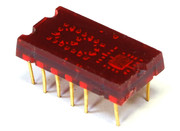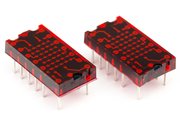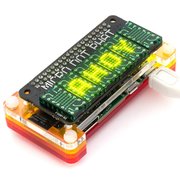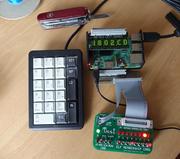RaspiElf Display
Intro
Long time ago I built a LED display and a hex keypad for my COSMICOS. I lend the COSMICOS and the extensions to a friend's brother and I saw the parts never again. Thanks to Lee Hart's 1802 Membership Card I own a 1802 SBC again. Now I need a display and a keypad for this gem.
I own a 1802 SBC again. Now I need a display and a keypad for this gem.
Hardware
TIL311 hexadecimal displays were to expensive for me 35 years ago and now they are not easy to get (and still expensive). The 4×7 rounded font looks far better than the seven-segment display especially the lower case hex display letters. But there is an alternative: LTP-305Software for the Raspberry Pi
The Raspi controls the display through its I2C interface. I still want to use the 1802 Membership Card'spi@cosmac:~/elf $ ls /dev/*i2c* /dev/i2c-1Detect the I2C chips:
pi@cosmac:~/elf $ i2cdetect -y 1
0 1 2 3 4 5 6 7 8 9 a b c d e f
00: -- -- -- -- -- -- -- -- -- -- -- -- --
10: -- -- -- -- -- -- -- -- -- -- -- -- -- -- -- --
20: -- -- -- -- -- -- -- -- -- -- -- -- -- -- -- --
30: -- -- -- -- -- -- -- -- -- -- -- -- -- -- -- --
40: -- -- -- -- -- -- -- -- -- -- -- -- -- -- -- --
50: -- -- -- -- -- -- -- -- -- -- -- -- -- -- -- --
60: -- 61 62 63 -- -- -- -- -- -- -- -- -- -- -- --
70: -- -- -- -- -- -- -- --
61, 62, and 63 are the I2C addresses of the IS31FL3730 chips.
How to get and build the RaspiElf Display Software
Theelfdisplay is part of the RaspiElf tools package. See RaspiElf#How_to_get_and_build_the_RaspiEl
Operating Modes (shown by decimal points)
Load
# ##### ### ##### ##### ######
## # # # # # # # # # #
# # # # # # # # # #
# ##### # # ##### # # #
# # # # # # # # #
# # # # # # # # # #
OOO ##### ##### ### ####### ### ##### ######
Run
# ##### ### ##### ##### ######
## # # # # # # # # # #
# # # # # # # # # #
# ##### # # ##### # # #
# # # # # # # # #
# # # # # # # # # #
##### OOO ##### ### ####### ### ##### ######
Wait
# ##### ### ##### ##### ######
## # # # # # # # # # #
# # # # # # # # # #
# ##### # # ##### # # #
# # # # # # # # #
# # # # # # # # # #
##### ##### OOO ### ####### ### ##### ######
Address
# ##### ### ##### ##### ######
## # # # # # # # # # #
# # # # # # # # # #
# ##### # # ##### # # #
# # # # # # # # #
# # # # # # # # # #
### ##### ##### ### OOO ####### ### ##### ######
Memory Protect
# ##### ### ##### ##### ######
## # # # # # # # # # #
# # # # # # # # # #
# ##### # # ##### # # #
# # # # # # # # #
# # # # # # # # # #
### ##### ##### ### ####### ### ##### OOO ######
TIL311 Emulator
The TIL311 has following inputs:- Data Inputs A, B, C, D
- Latch Input
- Blanking Input
- (Right and Left Decimal)
- Databus
- 8 Data Inputs
- no strobe
- Adressbus
- 8 Data Inputs
- 2 Latch Inputs
Comments
| I | Attachment | History | Action | Size | Date | Who | Comment |
|---|---|---|---|---|---|---|---|
| |
LED_module.jpg | r1 | manage | 79.2 K | 2018-05-03 - 20:14 | PeterSchmid | |
| |
Microdot_pHAT.jpg | r1 | manage | 164.3 K | 2018-05-03 - 20:17 | PeterSchmid | |
| |
keypad-display-s.jpg | r1 | manage | 56.2 K | 2018-05-20 - 18:46 | PeterSchmid | |
| |
keypad-display.jpg | r1 | manage | 718.0 K | 2018-05-20 - 16:12 | PeterSchmid | |
| |
til311-e4-519224.pdf | r1 | manage | 90.5 K | 2018-05-04 - 19:27 | PeterSchmid | |
| |
til311.jpg | r1 | manage | 96.4 K | 2018-05-03 - 20:14 | PeterSchmid |
Topic revision: r13 - 2018-09-28 - PeterSchmid
Ideas, requests, problems regarding TWiki? Send feedback







